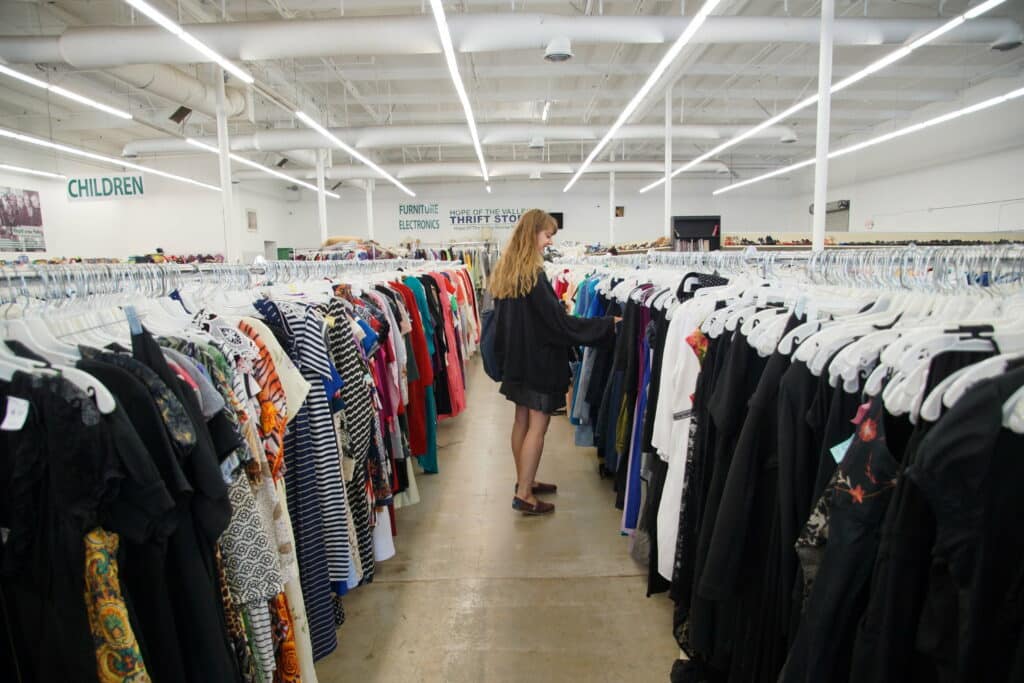Are you familiar with the term “fast fashion?” If not, you should be. It’s the hottest trend in the apparel industry today and it’s coming to a thrift store near you!
Fast fashion is defined in the fashion industry as inexpensive clothing produced rapidly by mass-market retailers in response to the latest trends. The idea is to get the newest styles on the market as fast as possible so shoppers can snap them up while they are still at the height of their popularity and then, sadly, discard them after a few wears. So, where are all these fast fashion castoffs going after they have worn out their welcome in the closet? To your neighborhood thrift store.
Fast-fashion players such as Zara, H&M Group, GAP, Forever 21, Esprit, Primark, and Shein, began flooding the U.S. market during Covid with inexpensive, fashion-forward garments, giving rise to this new market segment of the apparel industry and feeding consumer demand for inexpensive, more “on trend” garments that can be purchased online, drop-shipped to their door and discarded guilt-free when tossed to the back of the closet in favor of something new. And the financial returns for these fast fashion companies have been exponential.
Most of the growth and change in the fast fashion market can be attributed to Shein, a Chinese online fast fashion retailer who defines its business as “a global fashion and lifestyle e-retailer committed to making the beauty of fashion accessible to all.” Shein’s entry into the U.S. fast fashion market was kick-started at the beginning of the pandemic, following the trend of increased eCommerce spending while the world was in lockdown. The company’s U.S. sales roughly doubled between March and April of 2020 and grew from 11% of the market in 2020 to 40% as of March 2022.
Like so many new trends, temporary fame can have a downside According to a recent article in The New York Times entitled ‘The Golden Age of Thrifting is Over,’ a glut of fast fashion has made its way into local thrift stores, making it hard for women who have been purchasing secondhand for decades to find quality garments they can wear. The result, says a long-time thriftier quoted for this article, is that there is “just less and less desirable items. I’d go into thrift stores thinking I could find a few things for my wardrobe or for my family, and it would just be absolute, you know, garbage on the racks, like stained fast-fashion clothes that nobody wants.”
The rise of fast fashion has changed the way younger women shop for clothes, according to Megan McSherry, 25, a sustainable fashion educator. It is “nearly impossible,” she said, to scroll on social media without running into so-called haul videos showing hundreds, sometimes thousands of dollars worth of garments from Zara or Shein.
“Those hauls just encourage overconsumption,” Ms. McSherry said. “And there’s no way that all of those items are going to be constantly worn.”
That’s where your local thrift store comes in. “What isn’t worn ends up getting donated, says McSherry. While this closet-cleaning solution to fashion excess has substantially increased thrift store donations, it has also come at a cost. Thrift stores are being inundated with poor-quality clothing donations, leading to increased operating costs for the thrift store and impacting their bottom line. Stores need more employees and more time to sort through the clothes, inventory and space issues mean more clothes need to get either sold into the export market for a lower cost or disposed of, which has its own financial cost, and their lack of desirability means a loss of revenue.
“There’s all these clothes out there, but it’s just that they may not be as durable as you would like,” says Adam Minter, the author of “Secondhand: Travels in the New Global Garage Sale,” “Because of fast fashion, more than 60 percent of fabric fibers are now synthetics, derived from fossil fuels. This is alarming for the generations of women who have been thrifting for decades as a way of filling their closets affordably with garments made of high-quality materials.”
“You used to be able to find high-quality vintage items: silk, cashmere…That’s rarer now,” says Angela Petraline, owner of Dorothea’s Closet Vintage, an online boutique operated out of Des Moines, Iowa, who was quoted in this article. Adds Megan Miller, a lifelong thriftier, “I’d say that the golden age of thrifting is over.”
I share this article because of Megan Miller’s statement and the impact and unintended consequences of fast fashion on a segment of the antiques and collectibles marketplace that has long been a go-to hunting ground for good finds, not only among discerning shoppers looking for high-quality, soon-to-be vintage garments but for those seeking a rare find inside a box of donated items. Inside that box is the root of the old adage, ’one man’s junk is another man’s treasure,’ and what has made thrift stores such a popular place to sift and shop. So while there may be a more disproportionate amount of less-than-desirable fast fashion garments on the floor these days at your local thrift store, the finds inside the box are still there and worth the trip and your support.





Related posts: